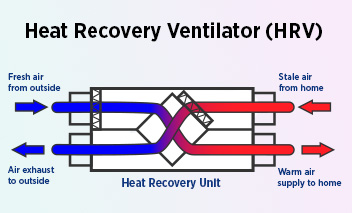Quick Guide: What to Consider Before Buying HRV
Wiki Article
How Heat Recovery Ventilation Improves Indoor Air Top Quality and Reduces Energy Costs
Heat Recovery Ventilation (HRV) systems play an essential function in boosting indoor air quality while concurrently decreasing energy costs. By successfully trading stale indoor air with fresh outside air, HRVs aid maintain optimal moisture and lower pollutants. Additionally, their capability to recuperate warm from outward bound air minimizes the strain on heating and cooling systems. As energy expenses proceed to climb, understanding the full potential of HRV systems becomes progressively essential for house owners and services alike.Recognizing Heat Recovery Ventilation Equipments

Heat recovery ventilation (HRV) systems play an essential role in enhancing interior air top quality, specifically in modern-day, energy-efficient structures. These systems are created to move warm from the outbound stale air to the incoming fresh air, therefore decreasing power loss while preserving optimal temperature levels indoors. HRVs contain a heat exchanger, followers, and ductwork, promoting the continual blood circulation of air. By getting rid of indoor pollutants and presenting fresh air, HRVs assist to balance moisture degrees, stop mold development, and minimize allergens. The efficiency of HRV systems exists in their capability to recuperate up to 80% of the warmth from the tired air, promoting power conservation while ensuring a healthy interior setting. Their integration is essential in attaining sustainable living practices.
The Relevance of Indoor Air High Quality
Indoor air quality (IAQ) is a vital factor affecting the health and wellness of occupants in any kind of environment. Poor IAQ can cause various health and wellness issues, including respiratory system problems, allergic reactions, and fatigue. Furthermore, it can aggravate status quo such as asthma. Aspects adding to low IAQ include toxins from indoor sources like cleaning up representatives, mold, and insufficient air flow. Consequently, preserving excellent IAQ is vital for promoting a risk-free and comfy living or functioning space. Efficient approaches to boost IAQ involve regular tracking of air top quality, proper ventilation systems, and reducing using harmful substances indoors. By prioritizing IAQ, individuals can ensure a much healthier setting that cultivates performance and total lifestyle.Power Effectiveness Advantages of HRV Equipments
Several house owners and building supervisors are significantly acknowledging the energy performance advantages of heat recuperation air flow (HRV) systems. By transferring warmth from worn down interior air to incoming fresh air, HRV systems noticeably minimize the energy required for heating and air conditioning. This process decreases reliance on conventional heating and cooling systems, bring about reduced energy expenses. Additionally, HRVs aid maintain a well balanced indoor environment, avoiding too much heating or cooling down demands. The capacity to recover approximately 90% of the heat from outward bound air also supports sustainability efforts by reducing general power consumption. HRV systems add not just to set you back savings but likewise to a decreased carbon impact, aligning with the expanding focus on energy-efficient structure practices.Installation and Maintenance Considerations
The reliable execution of heat recovery ventilation (HRV) systems requires cautious consideration of setup and upkeep variables to assure peak efficiency. Proper positioning of the HRV unit is necessary, as it needs to be mounted in an area that takes full advantage of air movement while decreasing sound interruption. In addition, ductwork has to be suitably sized and shielded to avoid power loss. Regular upkeep, including filter replacement and system cleaning, is crucial to secure optimal functionality and interior air top quality. Proprietors ought to establish a regular maintenance timetable to determine and attend to prospective issues before they rise. Partnership with knowledgeable experts during both installment and upkeep phases can enhance the long life and effectiveness of HRV systems, ultimately leading to far better indoor environments and lowered energy costs.
Real-World Applications and Success Stories
Discovering real-world applications of warm recovery air flow (HRV) systems exposes their significant effect on indoor air top quality and energy efficiency throughout various setups. In domestic structures, homeowners have actually reported improved air high quality, causing fewer allergic reactions and breathing issues. Schools carrying out HRV systems have kept in mind boosted trainee focus and decreased absence due to far better ventilation. Industrial structures, such as offices and retail areas, have actually experienced lower power prices and enhanced staff member productivity. A company office in a warm environment achieved a 30% reduction in power costs after installing an HRV system. These success stories show that HRV modern technology not just contributes to much healthier environments however additionally provides concrete monetary advantages, making it a valuable investment for different sectors.Often Asked Concerns
Can HRV Solutions Minimize Irritants in Indoor Air?
The effectiveness of HRV systems in decreasing interior irritants largely depends upon their ability to filter and exchange air. HRV Heat Recovery Ventilation. By continuously replacing stale air, these systems can greatly lower irritant degrees throughout indoor atmospheres
Exactly How Does Humidity Affect HRV System Efficiency?
Moisture greatly affects HRV system efficiency; high degrees can lead to condensation, minimizing performance, while reduced moisture might improve air exchange. Stabilizing humidity is necessary for ideal operation and maintaining indoor air top quality.Are HRV Equipments Noisy Throughout Procedure?
HRV systems can create differing sound levels during operation, relying on their layout and setup. Some systems operate silently, while others may generate noticeable audio, specifically at higher airflow settings or when poorly kept.What Is the Ordinary Life Expectancy of an HRV System?

Can HRV Equipments Be Utilized in All Climates?
HRV systems can be made use of in different climates, yet their performance may vary - HRV Heat Recovery Ventilation. In severe temperatures, changes or supplementary systems may be essential to ensure perfect efficiency and comfort while maintaining interior air qualityReport this wiki page